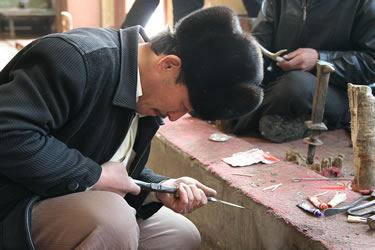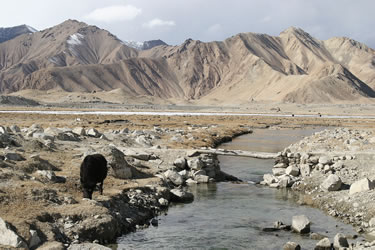Realities of the Silkroad

|
Lat:
39:28.998000
Long:
76:01.998000 Realities of the Silkroad
8th September 2006
 A relapse if you may. Spring in Kashgar brought new life to
the city. Trees blossomed afresh, t-shirts appeared on the streets and horses
broke their winter retirement. There was a vibrancy and pulse to the city I
hadn?€?t felt before and above everything else I felt an impending urge to get
going. A relapse if you may. Spring in Kashgar brought new life to
the city. Trees blossomed afresh, t-shirts appeared on the streets and horses
broke their winter retirement. There was a vibrancy and pulse to the city I
hadn?€?t felt before and above everything else I felt an impending urge to get
going.Following my return from the Taklamakan, days were mainly occupied sitting in Internet Cafes researching the next leg of the journey to Beijing. What lay ahead was far greater than I?€?d ever imagined yet also infinitely more exciting. The Long Desert Road Across Northern China the Great Gobi desert sprawls like a colossus; a seemingly endless series of desert and mountain ranges pressed together to form some of the greatest obstacles on Planet Earth. Since the dawn of trade, many a caravan has been lost in the icy passes or claimed by the winds of the deserts. Whether it be Polo?€?s desert of Lop, Fleming?€?s Tsaidam or Lattimore?€?s Mongol wastes, this journey would encompass them all. Every journey needs a beginning and Taxkorgan seemed the logical point for mine. I wanted to begin close to where I finished in Pakistan last year and this small Tajik town wasn?€?t far from the Pakistan border. From Taxkorgan, my journey begins on a well-oiled trail that runs over the Pamir Mountains to the edge of the Taklamakan desert. Here our caravan will skirt the fringes until the dusty town of Niya approx 700kms distant, on the Southern Silk Route. There a small track juts off across the Kunlun Mountains into the Northern Tsaidam Marshes and one of the most unknown regions on Earth today. By camel and horse/mule our path then extends over the Qilian Shan Mountains to Dunhuang and the end of the Great Wall. Heading East, Dunhuang lies at the head of the only strip of land in the region that permits access to China proper and the Chinese Empire has long taxed the caravan trade here through the Great Fort of Jiayuguan. To this day, Chinese still view the lands beyond the fort as the domains of barbarian hordes. After Jiayuguan, hoof, pad and foot must then make their way across the gravelly plains of Inner Mongolia to Beijing from which Genghis Khan?€?s Hordes once swept across the Earth. Many of the region?€?s Caravan routes were still in use until the 1950?€?s and it?€?s these that I hope to try to follow till the Chinese Capital. The total distance will be around 6000kms and it should take nine months to complete. Camel Business This certainly wasn?€?t going to be easy and the immediate issues were route planning, equipment, transport & logistics, permissions, sponsorships and media coverage and that was just the start. Throughout April I spoke with many personalities and experts who had considerable experience in the area. One of the most notable was John Hare, also head of the Wild Camel Protection Foundation. There are only 1000 camels left in the wild and many are located in the Wild Camel conservation area on the border of China?€?s Nuclear test site at Lop Nur. They seem to have adapted a remarkable tolerance to radiation and to drinking the salty brackish water of the area that other camels aren?€?t able to touch. All the evidence seems to point to the fact that the only remaining wild Bacterian camels in the world may be a separate species to their domestic cousin (see note). John?€?s advice also added extra impetus to planning the coming journey as thoroughly as possible. On the hard gravelly roads of the Gobi, two camels are always better in case one should go lame and you need a back up. Horses are often spooked by camels at the start of an expedition and it?€?s always wise to stable both animals together for at least two weeks prior to departure. Sponsors & Partners Throughout May, dust storms wracked Kashgar and I was excessively busy contacting old sponsors and new. Vettec sent out a fresh consignment of Superfast for the coming journey and freshly sponsored equipment arrived from Ranvet (antibiotic creams), Sea to Summit (Waterproof storage bags), Lyon Equipment (Ortlieb electronics and Documents bags) and Nexus (extended web-hosting options). As June rolled around, the ride also received fresh sponsorships from Costa Del Mar (sunglasses), Thorlos (Walking Socks). Kashgar Mountaineering Adventures (formerly Kashgar Mountaineering Association) stepped forward to join the project and are providing tremendous support organizing permits, equipment and finding suitable camel drivers to accompany the ride across North China. Ours will only be a small crew of two, (maximum three) persons when we finally set off from Taxkorgan. Although not fixed at this time, mostly camel drivers will accompany the expedition for 6 to 8 weeks at a time. The road ahead is long and none may be willing to part from their families for such extended periods. Media Coverage  Towards the end of May the Telegraph in Calcutta did a feature on the journey and in June both Expedition News and TNT Magazine covered the ride. In July, Lancashire Life Magazine (UK) published a four page feature I'd written on the endeavour and this coming October, Scouting Magazine (UK) will be doing the same. There has also been good local coverage from the Bolton Evening News, my home town newspaper. From April through June, I knew the intense highs of finding new sponsors but also the equally severe frustration of rejection. It was a steep learning curve and one that I?€?m still climbing each day. The UK media was especially difficult to break into and mainly this is due to the plethora of expeditions being launched nowadays. Many charities and organisations now arrange “Challenge for Charity” type projects and all are extremely worthwhile. It just makes this challenge that bit trickier - said with irony. Still, as the year has developed and plans have been put forward it was undeniably better to wait. Websites and Satellite Phones After the dramas of the World Cup in July, I settled down to tackle the last major challenge of the website. To update a website you need access to the web and accessing the web from a camel requires a Satellite phone and modem. Satellite phones are expensive, but call costs are astronomically so. Surfing the web takes time yet sending an email does not. Over the next two months I basically sat down to work out a system that would receive an email from the field and transform it into a style that fitted the rest of the site. Photos can be now be sent as attachments and the design is almost hassle free. There are also a heap of new features added and most importantly the bulk of the website work is now finished. When was I going to leave? In August I also faced a massive decision. When was I going to leave? It was absurd to keep working without a departure date in mind and I reasoned I had two choices.
The decision was carefully weighed up over 3 weeks and the advantages to leaving next year easily outweighed those for departing this year. Principally these were; more time to learn the languages I will need, find further sponsorships, work on last years documentary and make better arrangements. The oncoming winter was also an impending concern and it will be smoother to tackle this ride in one go, rather than split it up. Personally, considering the scale of the journey and the single opportunity to get it right, it was the right decision to make. Teaching in Dunhuang With money tight and the call of the Gobi on my doorstep, it has long been my plan to spend the winter teaching English near Dunhuang. Not only does the town lie at the end of the Great Wall, but it has long been the last bastion of civilization for those leaving China and the first oasis of life for those entering. The area around Dunhuang is also poor and will definitely benefit from an English teacher for three months. My only needs are food, lodgings and regular lessons in Chinese. Most importantly, Dunhuang is a place I can settle, learn Chinese and organize key logistics for the final stretch of the journey across Inner Mongolia. The city is a great depot for camels year round and securing friends and guides here will prove crucial when I arrive back here at the beginning of summer 2007 for the Gobi crossing. Thus from December 06 until end February 07 I should be available in Dunhuang to teach and I’m now waiting for confirmation from the local education authority. Fundraising Goal I'm now fixing a target of £10,000 to raise before I depart in March 2007. Life is busy, but incredibly rewarding and the skills I feel I've gained these past two years are immeasurable. Before November, I still have to find/purchase remaining equipment, secure greater media coverage and look for final sponsors. This is a dream and I'm determined to make it a successful one. The number one goal still remains to raise £100,000 to fund schools across India, Pakistan and China but the arrangements to secure a safe Chinese crossing have kept my mind off fundraising for a while. If you are reading this, do spare a thought to making an online or postal donation towards education which is the purpose of this ride. I?€?m fixing a target of £10,000 to raise before I depart in March 2007. The amount raised so far is undoubtedly disappointing and it?€?s time for a fresh effort to begin the final stage of the ride with good head start that will see the final goal of £100,000 reached at the finish. A Parting Thought Whenever the going got too tough over the last few months, I always thought back to the unlucky Pakistani tourist who had almost £400 (over 40,000 Rupees) stolen by a Chinese prostitute one late night in spring. What could he do? At 11pm he was trying to persuade an amused hotel staff to call the police. At 12am he was checking out and never came back. |